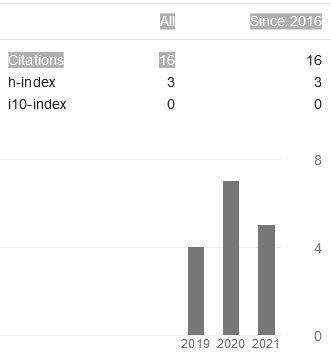Effect of Different Solvents in the Extraction Process of Kelor Moringa oleifera) Leaves on Bioactive Resources and Phenolic Acid Content
Abstract
Moringa (Moringa oleifera) plants are included in the category of medicinal plants because they contain various bioactive compounds that have the potential to prevent disease. Bioactive compounds can be extracted by maceration method using an appropriate solvent. The determination of the solvent is very influential on the extraction process because it is based on the similarity of the polarity value with the compound being dissolved. This study aims to determine the effect of different solvents on bioactive compounds and phenolic content in moringa leaf extract. The methods used were maceration with 96% ethanol and ethyl acetate solvents, phytochemical screening to determine the class of compounds, UV-Vis spectrophotometry to determine phenolic content, and FTIR to identify compounds. The results of phytochemical screening showed that ethanol extracts of moringa leaves are known to contain flavonoids, saponins, phenolic compounds, and triterpenoids. The results of the phenolic content test showed that the total phenolic content of the ethanol extract of moringa leaves was 34 mg GAE/g, while in the ethyl acetate extract of moringa leaves it was 2.216 mg GAE/g. The results of compound identification with FTIR showed that both moringa leaf extracts contained C-H (2850-2970 cm-1) and C=O (1690-1760 cm-1) functional groups. In addition, the ethanol extract also contained O-H functional group (3000-3500 cm-1).
Copyright (c) 2023 Fadila Ayu Puspitasari, Noviana Budianti Kartikasari, Sylvana Mutiyastika, Risa Purnamasari, Nova Lusiana, Eva Agustina

This work is licensed under a Creative Commons Attribution-ShareAlike 4.0 International License.
Authors who publish with us agree to the following terms:
- Authors retain copyright and grant the publisher right of first publication with the work simultaneously licensed under a Creative Commons Attribution License that allows others to share the work with an acknowledgement of the work's authorship and initial publication in this proceeding.
- Authors are able to enter into separate, additional contractual arrangements for the non-exclusive distribution of the proceeding's published version of the work (e.g., post it to an institutional repository or publish it in a book), with an acknowledgement of its initial publication in this proceeding.
- Authors are permitted and encouraged to post their work online (e.g., in institutional repositories, pre-prints sites or on their website) prior to and during the submission process, as it can lead to productive exchanges, as well as earlier and greater dissemination of published work





_page-00011.jpg)
